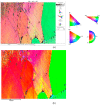Bronze Age Raw Material Hoard from Greater Poland: Archaeometallurgical Study Based on Material Research, Thermodynamic Analysis, and Experiments
- PMID: 38204085
- PMCID: PMC10780300
- DOI: 10.3390/ma17010230
Bronze Age Raw Material Hoard from Greater Poland: Archaeometallurgical Study Based on Material Research, Thermodynamic Analysis, and Experiments
Abstract
Hoard finds from the Bronze Age have appeared all over Europe, prompting questions about their functions (either as raw materials for recycling or votive objects). The hoard trove of raw materials from Przybysław in Greater Poland is an interesting example of a discovery that is related to the foundry activities of Late Bronze Age and Early Iron Age communities (c. 600 BC). The deposit consists of fragments of raw materials that were damaged end products intended for smelting. The research included the characterisation of the material in terms of the variety of the raw materials that were used. The individual elements of the hoard were characterised in terms of their chemical compositions, microstructures, and properties. A range of modern instrumental research methods were used: metallographic macroscopic and microscopic observations by optical microscopy (OM), scanning electron microscopy (SEM), chemical-composition analysis by X-ray fluorescence spectroscopy (ED-XRF), X-ray microanalysis (EDS), and detailed crystallisation analysis by electron microscopy with an emphasis on electron backscatter diffraction (EBSD). As part of this study, model alloys were also prepared for two of the selected chemical compositions, (i.e., CuPbSn and CuPb). These alloys were analysed for their mechanical and technological properties. This research of the hoard from Przybysław (Jarocin district, Greater Poland) has contributed to the recognition and interpretation of the function and nature of the hoard by using modern research and modelling methods as a cultic raw material deposit.
Keywords: CALPHAD; EBSD; ED-XRF; Late Bronze Age; SEM-EDS; archaeometallurgy; casting; computer modelling; copper; copper alloys; deposits; hoarding; metal hoards; metalwork; recycling.
Conflict of interest statement
The authors declare no conflicts of interest.
Figures













































References
-
- Dietrich O. Learning from ‘Scrap’ about Late Bronze Age Hoarding Practices: A Biographical Approach to Individual Acts of Dedication in Large Metal Hoards of the Carpathian Basin. Eur. J. Archaeol. 2014;17:468–486. doi: 10.1179/1461957114Y.0000000061. - DOI
-
- Bradley R. Hoards and the Deposition of Metalwork. In: Fokkens H., Harding A., editors. The Oxford Handbook of the European Bronze Age. Oxford Academic; Oxford, UK: 2013. pp. 121–139. - DOI
-
- Fontijn D. Traders «Hoards». In: Quilliec C.H.B., editor. Reviewing the Relationship between Trade and Permanent Deposition: The Case of the Dutch Voorhout hoard, Hoards from the Neolithicto the Metal Ages Technical and Codified Practices. Archaeopress; Oxford, UK: 2008. pp. 5–17. BAR International Series 1758. Publishers of British Archaeological Reports.
-
- Gori M. Circulation, Collection and Alienation of Bronze Artefacts in Late Bronze Age Europe. Gift Giving and the “Embedded” Economy in the Ancient World. Heidelberg Universitätsverlag; Heidelberg, Germany: 2014. Metal Hoards as Ritual Gifts; pp. 269–288.
-
- Nebelsick L. Rent Asunder: Ritual Violence in Late Bronze Age Hoards. In: Christopher F.E.P., editor. Metals Make the World Go Round. The Supply and Circulation of Metals in Bronze Age Europe. Oxbow Book; Oxford, UK: 2000. pp. 160–175.
Grants and funding
LinkOut - more resources
Full Text Sources
Research Materials

